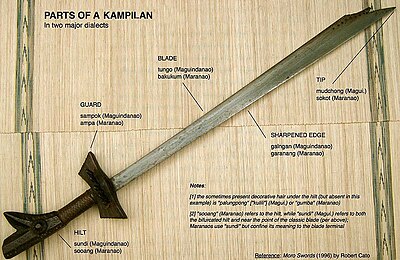Kampilan
| Kampilan - Manardas | |
|---|---|

Parts of the kampílan, written in Maguindanao and Maranao languages of Mindanao.
|
|
| Type | Sword |
| Place of origin | Philippines |
| Service history | |
| In service | Ancient barangays Rajahnate of Cebu Madja-as Tondo Namayan Maynila Rajahnate of Butuan Sultanate of Maguindanao |
| Used by | Kapampangans, Ilokanos, Visayans, Moros (Illanun, Maguindanao, Maranao, Sulu), Bajau |
| Wars |
Majapahit-Luzon wars Bruneian Invasion of Tondo Battle of Mactan Moro wars |
| Specifications | |
| Length | 90-100cm |
|
|
|
| Blade type | Single edge |
| Hilt type | Ivory , Wood , Gold |
| Scabbard/sheath | Wood |
The kampilan is a type of single-edged long sword, traditionally used by various ethnic groups in the Philippines archipelago.
The kampilan has a distinct profile, with the tapered blade being much broader and thinner at the point than at its base, sometimes with a protruding spikelet along the flat side of the tip and a bifurcated hilt which is believed to represent a mythical creature's open mouth.
The Maguindanao and the Maranao of mainland Mindanao preferred this weapon as opposed to the Tausūg of Sulu who favoured the barung. The Kapampangan name of the Kampilan was Talibong and the hilt on the Talibong represented the dragon Naga, however the creature represented varies between different ethnic groups. Its use by the Illocanos have also been seen in various ancient records. Pieces of Visayan kampilans are distinguished by their Mindanao counterparts by the way hilts are made. The native Meranau name of the Kampilan was Kifing, while the Iranun language it is known as Parang Kampilan.
A notable wielder of the kampílan was Datu Lapu-Lapu (the king of Mactan) and his warriors, who defeated the Spaniards and killed Portuguese explorer Ferdinand Magellan at the Battle of Mactan on April 27, 1521.
The kampílan was earliest mentioned in ancient Filipino epics in Hiligaynon Hinilawod from the Visayas and Ilocano Biag ni Lam-Ang from Luzon. This particular design of sword was not uncommon among the various ethnic tribes throughout the pre-Hispanic Philippine archipelago. the early Today, the kampílan is portrayed in Filipino art and ancient tradition.
...
Wikipedia
